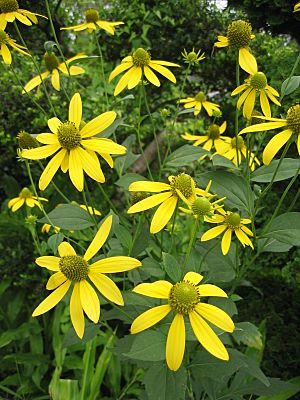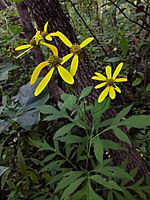Cutleaf coneflower facts for kids
Quick facts for kids Rudbeckia laciniata |
|
|---|---|
 |
|
| Scientific classification | |
| Genus: |
Rudbeckia
|
| Species: |
laciniata
|
Rudbeckia laciniata, commonly called cutleaf coneflower, is a species of flowering plant in the aster family (Asteraceae). It is native to North America, where it is widespread in both Canada and the United States. Its natural habitat is wet sites in flood plains, along stream banks, and in moist forests.
Contents
Description
It is a robust herbaceous perennial growing up to 3 m (10 ft) tall. It has broadly ovate and somewhat glaucous leaves that are often deeply dissected. The composite flowers are produced in late summer and autumn. The disc flowers are green to yellowish green, while the rays are pale yellow.
The specific epithet laciniata refers to the pinnately divided leaves.
Taxonomy
Up to six varieties of Rudbeckia laciniata are currently recognized. The varieties ampla and heterophylla are considered to be the most distinctive, while the others less so. There is variation in treatment among authors, with the less distinctive varieties sometimes being subsumed into laciniata, and variety ampla sometimes recognized at the species level.
The six varieties are:
- R. laciniata var. ampla - Native west of the Great Plains, into to the Rocky Mountains.
- R. laciniata var. bipinnata - Native to New England and the Mid-Atlantic area.
- R. laciniata var. digitata - Native to the Southeastern Coastal Plain.
- R. laciniata var. heterophylla - Endemic to Levy County, Florida.
- R. laciniata var. humilis - Native to the southern Appalachian Mountains.
- R. laciniata var. laciniata - Widespread and common, native across eastern North America.
-
Variety humilis has shallowly lobed leaves and large flowers (Clingman's Dome, North Carolina)
-
Variety laciniata, showing deeply divided leaves (Theodore Roosevelt Island, Washington, D.C.)
Names
Common names other than cutleaf coneflower include "cutleaf", "goldenglow", "green-headed coneflower", "tall coneflower", "sochan" and "thimbleweed".
Cultivation
Rudbeckia laciniata is widely cultivated in gardens and for cut flowers. Numerous cultivars have been developed, of which 'Herbstsonne' ("Autumn sun") and ‘Starcadia Razzle Dazzle’ have gained the Royal Horticultural Society's Award of Garden Merit.
The Lady Bird Johnson Wildflower Center notes that " Because it spreads rampantly by underground stems, cut-leaf coneflower is only appropriate for large sites."
Uses
Traditionally, the young leaves have been gathered from the wild and eaten in the early spring. They are greatly favored as a potherb (cooked). Though some references state the use of this plant as salad greens (raw), traditional use is as cooked greens. This is assumed to be done to remove toxins. However, there is little evidence of their presence. One report cites circumstantial evidence of poisoning to horses, sheep and pigs.
Images for kids




